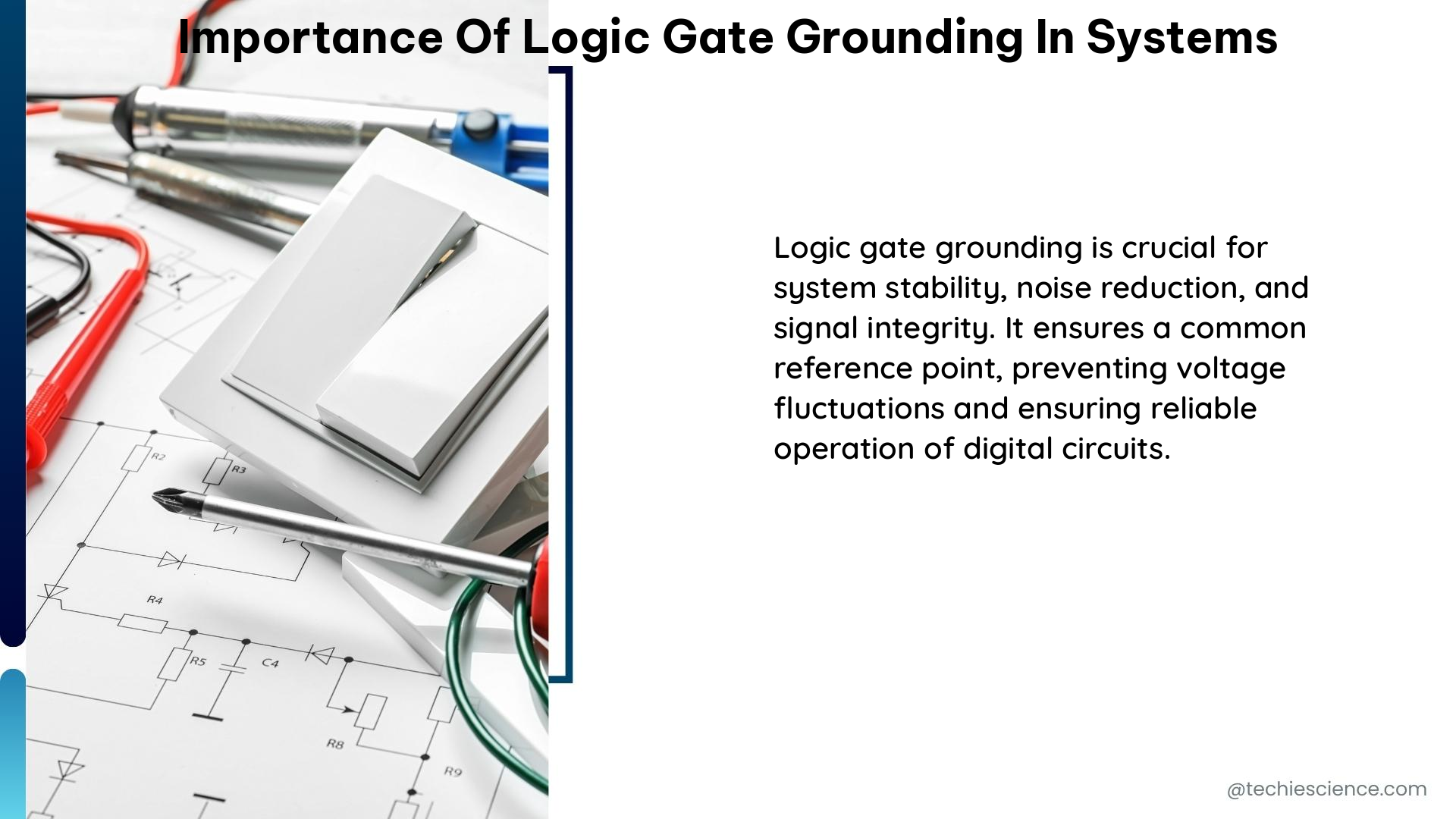The importance of logic gate grounding in electronic systems cannot be overstated, as it directly impacts the functionality, reliability, and performance of these systems. Proper grounding is the foundation upon which the stability and integrity of electronic devices and circuits depend. This comprehensive guide delves into the technical details and best practices for ensuring effective logic gate grounding, equipping electronics professionals and enthusiasts with the knowledge to optimize their systems.
Understanding the Significance of Logic Gate Grounding
Logic gates are the fundamental building blocks of digital electronic circuits, responsible for performing Boolean logic operations. Proper grounding of these logic gates is crucial for maintaining the correct logic levels and ensuring reliable communication between various components in the system.
Maintaining Stable Voltage Levels
Grounding plays a vital role in maintaining stable voltage levels within a system. If the grounding is compromised, voltage drops or fluctuations can occur, leading to invalid logic levels. This can result in errors in data transmission and communication between devices, causing malfunctions and unreliable system behavior.
Mitigating Electromagnetic Interference (EMI)
Grounding is also essential for mitigating the effects of electromagnetic interference (EMI) in electronic systems. EMI can cause high-frequency signals to interfere with data and measurements, leading to data corruption and measurement errors. Proper grounding helps to reduce EMI at the source, block its propagation, and minimize the susceptibility of circuits and devices to such interference.
Adherence to Industry Standards
The SEMI Standard E.176 is a crucial reference for managing EMI in semiconductor manufacturing and handling. This standard specifies the maximum allowed EMI voltages and currents on the ground, providing guidelines for maintaining a clean and stable ground environment. Adhering to these standards is essential for ensuring the reliability and performance of electronic systems.
Measuring and Quantifying Ground Voltages and Currents

To ensure proper grounding, it is necessary to measure and quantify ground voltages and currents, as these parameters directly impact the functionality and reliability of electronic systems. Proper instrumentation and techniques are essential for such measurements, and understanding the methodology is critical for resolving EMI issues on the ground.
Instrumentation and Measurement Techniques
Specialized instrumentation, such as high-impedance voltmeters and current probes, is required to accurately measure ground voltages and currents. These measurements must be performed with care to avoid introducing additional interference or disturbances to the system.
Interpreting Measurement Results
Analyzing the measured ground voltages and currents is crucial for identifying and addressing any issues related to grounding. The measured values must be compared to the industry standards, such as SEMI E.176, to ensure compliance and identify potential problem areas.
Practical Considerations for Logic Gate Grounding
Implementing effective logic gate grounding in electronic systems requires a comprehensive understanding of the underlying principles and best practices. Here are some key considerations to keep in mind:
Grounding Topologies and Techniques
Different grounding topologies, such as single-point, multi-point, and star grounding, have their own advantages and disadvantages. The choice of grounding topology should be based on the specific requirements of the system and the potential sources of EMI.
Grounding Impedance and Resistance
The impedance and resistance of the grounding system play a crucial role in its effectiveness. Minimizing the grounding impedance and resistance helps to ensure a stable and reliable ground reference, reducing the risk of voltage drops and EMI issues.
Grounding Conductor Selection and Routing
The selection and routing of grounding conductors are essential for maintaining a low-impedance ground path. Factors such as conductor size, material, and length must be carefully considered to optimize the grounding system.
Bonding and Shielding Techniques
Proper bonding and shielding techniques are necessary to ensure effective grounding and EMI mitigation. This includes the use of conductive enclosures, shielded cables, and strategic placement of ground connections.
Troubleshooting and Optimization Strategies
When faced with issues related to logic gate grounding, a systematic troubleshooting approach is crucial. This may involve analyzing measurement data, identifying potential sources of interference, and implementing corrective measures to optimize the grounding system.
Identifying and Resolving Grounding Issues
Common grounding issues, such as ground loops, ground faults, and improper ground connections, must be identified and addressed to ensure the reliability and performance of the electronic system.
Optimization Techniques
Optimization techniques, such as adjusting grounding topologies, improving conductor routing, and enhancing bonding and shielding, can help to further improve the effectiveness of the logic gate grounding system.
Conclusion
The importance of logic gate grounding in electronic systems cannot be overstated. Proper grounding is essential for maintaining stable voltage levels, mitigating electromagnetic interference, and ensuring the overall reliability and performance of digital circuits and devices. By understanding the technical details and best practices outlined in this guide, electronics professionals and enthusiasts can effectively design, implement, and troubleshoot logic gate grounding systems, contributing to the development of robust and dependable electronic solutions.
References:
– Importance of System-Level Grounding
– Grounding Techniques for Analog and Digital Electronics
– Measuring Ground Voltages and Currents
– SEMI Standard E.176: Specification for Electromagnetic Compatibility (EMC) of Semiconductor Manufacturing Equipment

The lambdageeks.com Core SME Team is a group of experienced subject matter experts from diverse scientific and technical fields including Physics, Chemistry, Technology,Electronics & Electrical Engineering, Automotive, Mechanical Engineering. Our team collaborates to create high-quality, well-researched articles on a wide range of science and technology topics for the lambdageeks.com website.
All Our Senior SME are having more than 7 Years of experience in the respective fields . They are either Working Industry Professionals or assocaited With different Universities. Refer Our Authors Page to get to know About our Core SMEs.